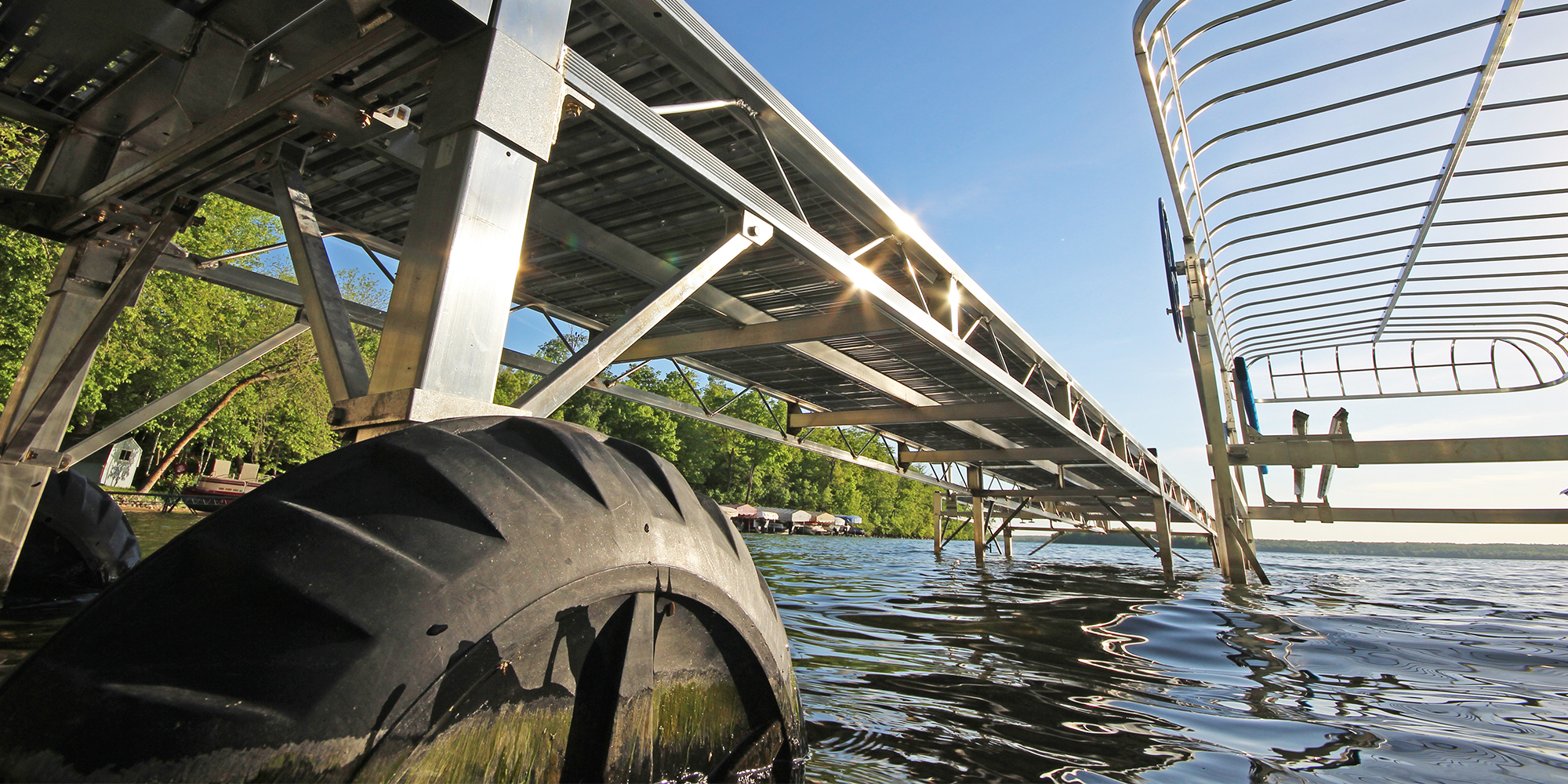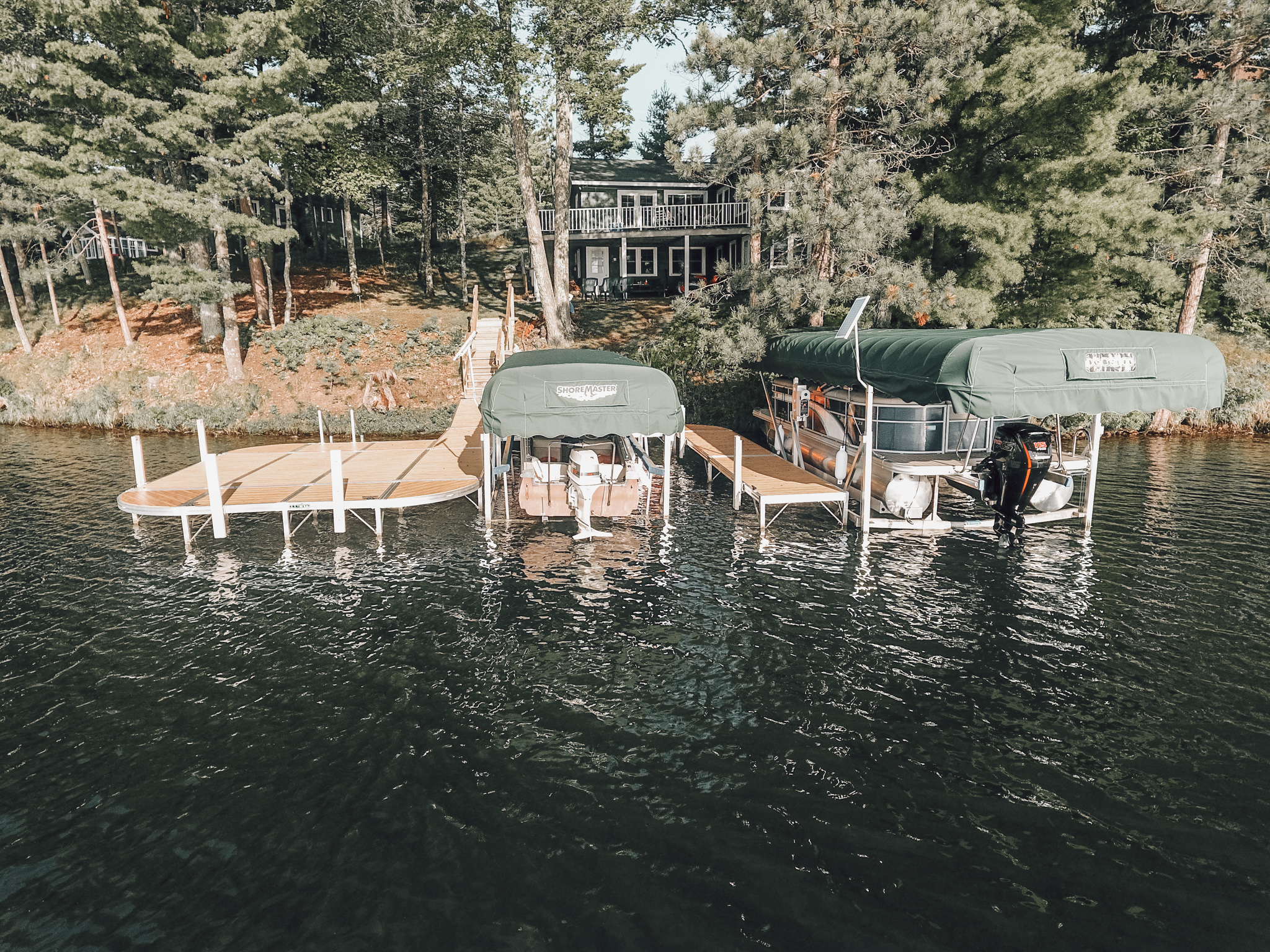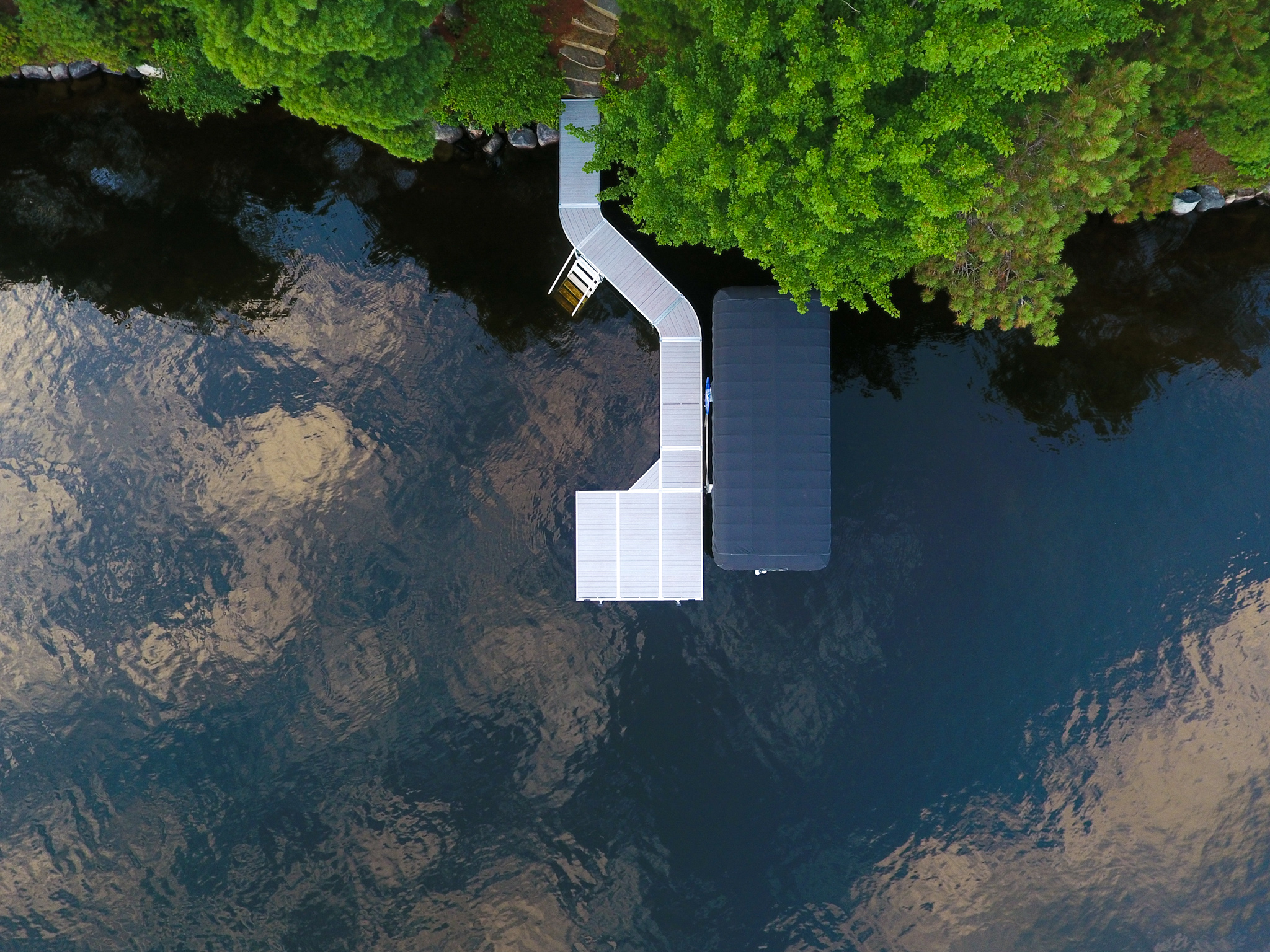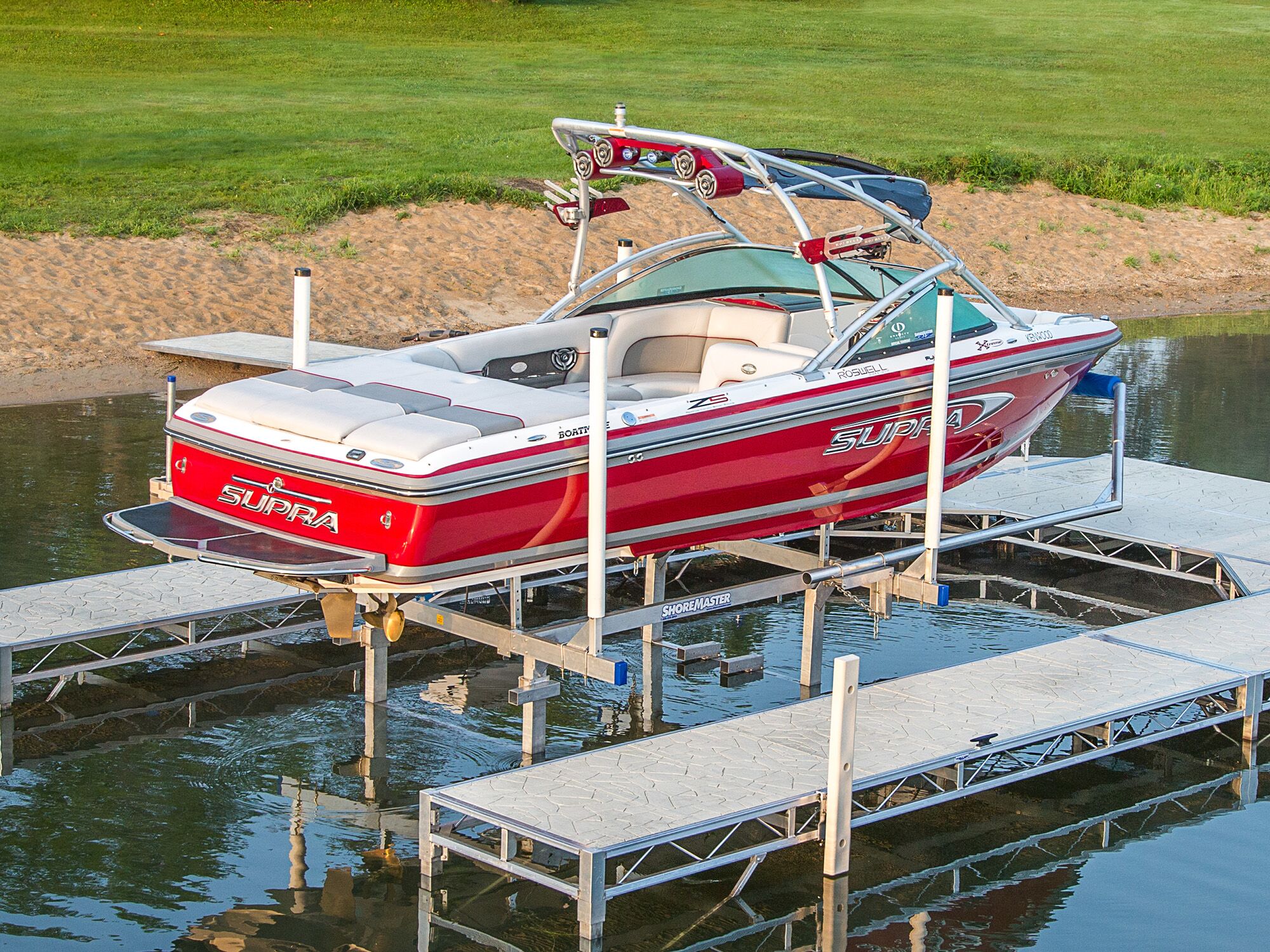June 20, 2024
Roll-In Dock Options, Benefits, & Installation
Written by ShoreMaster Marketing
Seasons change, water levels fluctuate, and waterfront needs evolve. These are the realities of boating life. They're also why roll-in docks have been a popular choice for waterfront owners. Below, we dive into the intricacies of roll-in docks, what makes them a solid docking solution, and why you should consider building your dream dock with ShoreMaster.

Overview of Roll-In Docks
Ease of use, flexibility, and practicality are at the core of what makes roll-in docks popular among waterfront property owners. They combine a lightweight aluminum frame with rotomolded wheels, making seasonal installation and removal a breeze. Meanwhile, their modular design enables waterfront owners to configure them into various layouts depending on their needs.
Roll-in docks are ideal for areas with gradual slopes and soft or rocky bottoms. The best roll-in dock systems also feature adjustable legs, enabling easy adjustments to accommodate changing water levels or uneven lake beds. Overall, roll-in docks provide a practical and efficient solution for waterfront property owners, making them an excellent investment for enhancing waterfront living and recreational experiences.
Varieties and Features of Roll-In Docks
ShoreMaster offers two roll-in dock models — the Infinity RS7 and the Infinity TS9. Built on our Infinity Dock Systems, these premium solutions boast industry-leading strength and stability, unlimited configurability, and high-end aesthetics bundled around ease of ownership for the ultimate dock experience.
Here’s a closer look at what sets these roll-in dock systems apart from the competition:
- QC Frame Assembly: With the QC (Quick Connect) frame assembly, you get the installation without the drilling. Its simple T-handle tightening system provides hassle-free installation and adjustments, allowing you to let the good times roll.
- Lightweight Aluminum Frame System: Both the RS7 and TS9 utilize a lightweight aluminum frame with precision welded construction. This design ensures durability without compromising ease of installation and removal.
- 5-Sided Dock Legs with 18” Leg Pocket: Our 5-sided dock legs provide three contact points for enhanced stability and safety, while the 18” leg pockets allow you to adjust the dock height for fluctuating water levels between boating seasons.
- Infinity Track Accessory System: This system utilizes a series of modular tracks along the dock frame, enabling tool-free accessory installation whenever you need them. From benches, chairs, and ladders to kayak racks, bumpers, and fishing rod holders, if you can do it on the water, we have an accessory to help you enjoy it better.
- Premium Decking Options: We believe the perfect dock system should look just as good as it performs. We offer nine decking options, allowing you to create a dock that reflects your personal style or blends seamlessly with the environment. Whether you fancy flow-through polypropylene, wood-grain aluminum, or the unique flagstone pattern of Vertex™, our premium decking options ensure your dock is not only highly functional but also aesthetically pleasing.
The primary difference between the RS7 and the TS9 is their side rail design. The RS7 features a 6.75-inch side rail frame, while the TS9 sports a classic truss side design. Regardless of your choice, you get a versatile dock system that perfectly blends reliability, functionality, and design to accommodate all your waterfront activities with style.
Installation Guide for Roll-In Docks
Installing a roll-in dock can be a rewarding experience for DIY enthusiasts. Here’s a general outline of how to install a roll-in dock:
- Check local regulations: Verify any local regulations or permits required for installing docks in your area. In certain states, docks under 500 square feet may be exempt from specific regulations. In Michigan, for example, seasonal docks installed in an inland lake or stream do not require permits (State of Michigan, n.d.).
- Site preparation: Ensure the area is free from obstructions like large rocks or debris that could hinder the installation. Measure the depth and slope of the shoreline to determine the appropriate configuration of the dock legs. Use stakes or markers to outline where the dock will sit, ensuring it aligns with your desired layout.
- Assembly: Lay out all the components and follow the manufacturer’s instructions for assembling dock sections. Typically, this involves connecting the frames and the dock wheel kit and attaching the decking.
- Positioning: Once assembled, position the dock at the water’s edge. Set the leg height according to the previously noted measurements.
- Rolling In: Ensure the wheels are aligned and move the dock slowly to avoid any damage to the components or lake bed. We offer a boat lift wheel caddy for easy integration if you have a lift.
- Securing: Once the dock is in the desired position, secure it by adjusting the legs for optimal height and stability and anchoring it to the shoreline if necessary. Check that all connections are tight and that the dock is level.
- Final adjustments: Test the dock’s stability by walking on it and checking for wobbling or movement. Make the necessary adjustments to ensure the dock is stable and secure.
Installing a roll-in dock can be a straightforward and rewarding DIY project, especially with ShoreMaster’s user-friendly designs. However, should you prefer professional installation, our extensive network of local dealers will gladly assist you.
How Much Does a Roll-In Dock Cost?
The cost of a roll-in dock can vary widely depending on several factors, including the size, materials, and additional features. On average, a basic roll-in dock may range from $1,500 to $3,000. Larger docks with more advanced features and accessories can cost upwards of $12,000. While this may seem like a significant investment, it’s essential to consider the return and long-term savings quality roll-in docks offer.
The average yearly cost to dock a boat in the US is $1,300. This number can reach $5,000 or more for prime locations (Town and Tourist, 2022). Aside from eliminating docking fees, properties equipped with quality boat docks are often perceived as premium real estate, attracting buyers who appreciate water access's convenience and lifestyle benefits. Meanwhile, their durable construction and low maintenance requirements translate to fewer repair and replacement costs over time.
Why Choose ShoreMaster for Your Roll-In Dock
ShoreMaster was born in 1972 on the lakes of Carlos, Minnesota, when Dennis Tuel, Sr. embarked on a mission to create boat lifts that were easier to install, built to last, and allowed owners to maximize their time on the water. In the five decades since then, we’ve stayed true to the ethos of producing quality docking solutions centered around innovation and ease of use.
Easy to install, maintain, and customize, our roll-in dock systems are designed to evolve with you. While you can’t buy time to spend on the water, you can invest in a dock system that allows you to make the most of it. Contact us today to explore our range of boat docks and transform your waterfront experience forever.
References:
- State of Michigan (n.d.). Docks, Boat Hoists, and Swim Rafts. Retrieved from Docks-Boat-Hoists-Swim-Raft-Handout.pdf (michigan.gov)
- Town and Tourist (October 22, 2022). How Much Does It Cost To Dock a Boat? (Long-term & Short-term Costs!). Retrieved from How Much Does It Cost To Dock a Boat? (Long-term & Short-term Costs!) (townandtourist.com)



